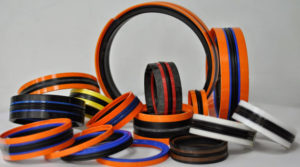 A few of the important parameters that one needs to consider while selecting a seal are system operating pressure, seal material compatibility with fluid and fluid operating temperature, resistance against extrusion, expected service life, ease of installation, cost of procurement and logistics.
A few of the important parameters that one needs to consider while selecting a seal are system operating pressure, seal material compatibility with fluid and fluid operating temperature, resistance against extrusion, expected service life, ease of installation, cost of procurement and logistics.
System operating pressure is one of the predefined seal limitations. Different types of equipment ranging from a simple hydraulic press to aircraft operate at different working pressure and hence require different sealing solutions. Critical parameters like radial clearance between the seal and the cylinder bore, groove width, groove diameter etc., vary at different operating pressure. Thus, for a given system pressure, values for the aforementioned parameters can be directly taken from the manufacturer’s catalog.
The next important consideration is the seal material and the expected fluid temperature during operation. For handling of petroleum products and diesters, seals made of rubber nitrile (also known as Buna N) are preferred. In case of handling phosphate ester-based fluids (like that of Skydrol), ethylene propylene seals are preferred. It is interesting here to note that the seal-fluid combination should also give rise to sufficient lubricating fluid film between the seal and the sliding surface. The lubricating fluid film is important for even movement and reduction of friction between two sliding members. Most dynamic seals do not automatically create the lubricating fluid film and this leads to intermittent stick and slip from the surface (Stick Slip Motion). To avoid this condition, low friction seal materials like PTFE (commonly known as Teflon) are used. A seal material also must be able to resist extrusion into the radial clearance between the piston and cylinder bore. Hardening of seal material or the use of back-up rings will usually suffice this condition.
Working temperature of the seal material also plays a critical role in seal selection. At lower temperatures, seals tend to lose their sealing action and higher temperatures lead to enhanced seal wear (due to poor formation of lubricating fluid film). This leads to reduction in seal service life. As a rule of thumb, it is said that, every 10° C rise in fluid temperature leads to approximately 50% reduction in seal’s expected service life.
Contributed by Harshavardhan Joshi, Aircraft Hydraulic Systems Engineer, CSIR – National Aerospace Laboratories, India
The post How do I select a proper seal for my application? appeared first on Sealing & Contamination Control Tips.
Filed Under: Sealing, Sealing & Contamination Control Tips, Slider